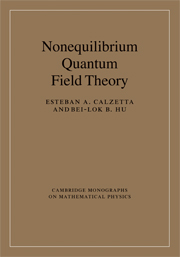Book contents
- Frontmatter
- Contents
- Preface
- I FUNDAMENTALS OF NONEQUILIBRIUM STATISTICAL MECHANICS
- II BASICS OF NONEQUILIBRIUM QUANTUM FIELD THEORY
- III GAUGE INVARIANCE, DISSIPATION, ENTROPY, NOISE AND DECOHERENCE
- 7 Closed time path effective action for gauge theories
- 8 Dissipation and noise in mean field dynamics
- 9 Entropy generation and decoherence of quantum fields
- IV THERMAL, KINETIC AND HYDRODYNAMIC REGIMES
- V APPLICATIONS TO SELECTED CURRENT RESEARCH
- References
- Index
7 - Closed time path effective action for gauge theories
from III - GAUGE INVARIANCE, DISSIPATION, ENTROPY, NOISE AND DECOHERENCE
- Frontmatter
- Contents
- Preface
- I FUNDAMENTALS OF NONEQUILIBRIUM STATISTICAL MECHANICS
- II BASICS OF NONEQUILIBRIUM QUANTUM FIELD THEORY
- III GAUGE INVARIANCE, DISSIPATION, ENTROPY, NOISE AND DECOHERENCE
- 7 Closed time path effective action for gauge theories
- 8 Dissipation and noise in mean field dynamics
- 9 Entropy generation and decoherence of quantum fields
- IV THERMAL, KINETIC AND HYDRODYNAMIC REGIMES
- V APPLICATIONS TO SELECTED CURRENT RESEARCH
- References
- Index
Summary
In this chapter we treat out-of-equilibrium behavior of gauge fields, particularly of the nonabelian kind. This is a broad topic, so we will only discuss some specific points.
Overall, we may distinguish two sets of features that make problems involving gauge fields different from those where only “matter” fields are present. On the one hand, there are “technical” differences associated with the fact that problems involving gauge fields usually abound with massless degrees of freedom. An important example is the so-called “hard thermal loop” problem, which is discussed in Chapter 10. We also consider “technical” difficulties associated with a particular symmetry breaking pattern or with the property of confinement, which clearly has a strong impact on the nonequilibrium phenomenology of QCD. Because of the rich variety of behavior, these problems are best treated on a case by case basis. In Chapter 14, for example, we give a brief account of nonequilibrium phenomena in relativistic heavy ion collisions.
On the other hand, there is an intrinsic difference between gauge and nongauge theories, coming from the fact that the “natural” description of the former in terms of spacetime fields is redundant. For example, the most efficient description of the Maxwell field is in terms of the potential 4-vector, but many different 4-vectors describe the same physical electromagnetic field. There is an intrinsic ambiguity in the equations of motion of the theory, which do not determine the evolution completely.
- Type
- Chapter
- Information
- Nonequilibrium Quantum Field Theory , pp. 211 - 230Publisher: Cambridge University PressPrint publication year: 2008

